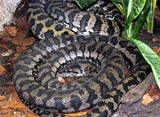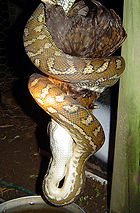
Morelia spilota variegata
Encyclopedia
Morelia spilota variegata is a subspecies of python found in New Guinea
and Australia
, smaller than the nominate subspecies Morelia spilota spilota and has a more restricted geographic range.
 Adults usually grow no more than 2m, but some have been recorded at 2.5m. There was however, one exception, one M.s. Variegata was recorded at 80cm at four years old.
Adults usually grow no more than 2m, but some have been recorded at 2.5m. There was however, one exception, one M.s. Variegata was recorded at 80cm at four years old.
The color pattern consists of a beige or brown ground color overlaid with blackish or gray blotches, cross-bands or stripes, or a combination of any of these. Regional color variations can include bright yellow, gold, rust and clear grays.
Common names include carpet python
, Northwestern carpet python, Irian Jaya carpet python, West Papuan carpet python, Proserpine carpet python.
(Western New Guinea
and Papua New Guinea
) and Australia
in northwestern Western Australia
and in the northern portion of the Northern Territory
. The type locality given is "North Australia: Port Essington" (Northern Territory, Australia).
. Their diet is varied and includes many different birds and mammals. Populations that inhabit forested areas are mostly arboreal and often feed on brush-tailed possums, Trichosurus.
New Guinea
New Guinea is the world's second largest island, after Greenland, covering a land area of 786,000 km2. Located in the southwest Pacific Ocean, it lies geographically to the east of the Malay Archipelago, with which it is sometimes included as part of a greater Indo-Australian Archipelago...
and Australia
Australia
Australia , officially the Commonwealth of Australia, is a country in the Southern Hemisphere comprising the mainland of the Australian continent, the island of Tasmania, and numerous smaller islands in the Indian and Pacific Oceans. It is the world's sixth-largest country by total area...
, smaller than the nominate subspecies Morelia spilota spilota and has a more restricted geographic range.
Description

The color pattern consists of a beige or brown ground color overlaid with blackish or gray blotches, cross-bands or stripes, or a combination of any of these. Regional color variations can include bright yellow, gold, rust and clear grays.
Naming
A number of synonyms refer to this subspecies: Morelia variegata - Gray, 1842; Morelia variegata - Gray, 1849; Morelia argus variegata - Jan & Sordelli, 1864; Morelia argus variegata - Mitchell, 1951; Morelia spilotes variegata - Mitchell, 1955; Morelia argus variegata - Stimson, 1969; Python spilotus variegatus - L.A. Smith, 1981; Morelia variegata - Wells & Wellington, 1984; and * Morelia spilota variegata - Barker & Barker, 1984.Common names include carpet python
Carpet python
Morelia spilota is a large snake of the Pythonidae family found in Australia, Indonesia and New Guinea. There are 6 subspecies listed by ITIS, commonly referred to as Carpet and Diamond pythons.-Description:...
, Northwestern carpet python, Irian Jaya carpet python, West Papuan carpet python, Proserpine carpet python.
Geographic range
Found in New GuineaNew Guinea
New Guinea is the world's second largest island, after Greenland, covering a land area of 786,000 km2. Located in the southwest Pacific Ocean, it lies geographically to the east of the Malay Archipelago, with which it is sometimes included as part of a greater Indo-Australian Archipelago...
(Western New Guinea
Western New Guinea
West Papua informally refers to the Indonesian western half of the island of New Guinea and other smaller islands to its west. The region is officially administered as two provinces: Papua and West Papua. The eastern half of New Guinea is Papua New Guinea.The population of approximately 3 million...
and Papua New Guinea
Papua New Guinea
Papua New Guinea , officially the Independent State of Papua New Guinea, is a country in Oceania, occupying the eastern half of the island of New Guinea and numerous offshore islands...
) and Australia
Australia
Australia , officially the Commonwealth of Australia, is a country in the Southern Hemisphere comprising the mainland of the Australian continent, the island of Tasmania, and numerous smaller islands in the Indian and Pacific Oceans. It is the world's sixth-largest country by total area...
in northwestern Western Australia
Western Australia
Western Australia is a state of Australia, occupying the entire western third of the Australian continent. It is bounded by the Indian Ocean to the north and west, the Great Australian Bight and Indian Ocean to the south, the Northern Territory to the north-east and South Australia to the south-east...
and in the northern portion of the Northern Territory
Northern Territory
The Northern Territory is a federal territory of Australia, occupying much of the centre of the mainland continent, as well as the central northern regions...
. The type locality given is "North Australia: Port Essington" (Northern Territory, Australia).
Feeding
The snake is not venomous and kills prey by constrictionConstriction
Constriction is a method used by various snake species to kill their prey. Although some species of venomous and mildly-venomous snakes do use constriction to subdue their prey, most snakes which use constriction lack venom. The snake initially strikes at its prey and holds on, pulling the prey...
. Their diet is varied and includes many different birds and mammals. Populations that inhabit forested areas are mostly arboreal and often feed on brush-tailed possums, Trichosurus.
Reproduction
Oviparous, females deposit their eggs in secluded places such as hollow logs and tree boles where they protect and incubate them. Captive specimens have produced up to 18 eggs that hatch after a 40 day incubation period. The hatchlings are about 12 inches (30 cm) in length.External links
- M. s. variegata range map at Kingsnake.com. Accessed 4 May 2008.
- Irian Jaya carpet python breeding cycle at Antaresia.com. Accessed 4 May 2008.

